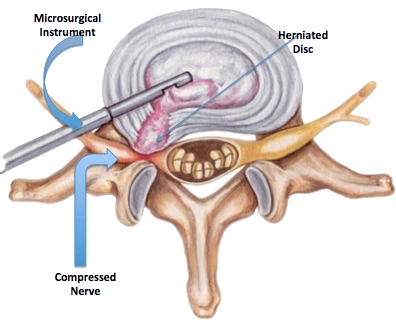Spine Surgeon
Microdiscectomy surgery in Mumbai
Microdiscectomy
Microdiscectomy is a minimally invasive surgical procedure aimed at alleviating pressure on pinched nerves, often associated with conditions like sciatica or lumbar radiculopathy. During the procedure, the surgeon removes the protruding intervertebral disc material, offering relief. Compared to open discectomies and lumbar fusion surgeries, recovery from microdiscectomy is typically faster.
What are the types of microdiscectomy?
- Traditional Microdiscectomy: Involves a small incision in the lower back to remove herniated disc material, relieving pressure on spinal nerves.
- Endoscopic Microdiscectomy: Minimally invasive technique using specialized instruments and an endoscope for visualization, allowing for smaller incisions and reduced tissue disruption.
- Laser Microdiscectomy: Utilizes laser technology to vaporize or shrink herniated disc material, offering a less invasive option for decompression.
- Percutaneous Microdiscectomy: Involves accessing the spine through tiny incisions with specialized instruments, often guided by fluoroscopy, to remove herniated disc material with minimal tissue disruption.
What conditions does microdiscectomy treat, & how does it relieve symptoms?
Herniated Disc: Microdiscectomy is often used to alleviate symptoms caused by a herniated or ruptured intervertebral disc, which can lead to nerve compression and associated pain, weakness, or numbness.
Sciatica: Microdiscectomy can provide relief for individuals experiencing sciatica, a condition characterized by pain radiating along the sciatic nerve pathway, typically caused by compression of spinal nerves due to a herniated disc.
Lumbar Radiculopathy: This condition, also known as pinched nerve or nerve root compression, occurs when spinal nerves in the lumbar region are compressed or irritated, leading to symptoms such as pain, numbness, or weakness in the lower back and legs.
Degenerative Disc Disease: In cases where degenerative changes in the spinal discs contribute to nerve compression or irritation, microdiscectomy may be recommended to alleviate symptoms and improve spinal stability.
Other Spine-related Conditions: Microdiscectomy may also be used to address other spine-related conditions causing nerve compression or irritation, such as spinal stenosis or foraminal stenosis.
How is the procedure performed?
The microdiscectomy procedure involves making a small incision in the lower back, through which the surgeon accesses the affected area of the spine. Using specialized instruments and magnification, the surgeon carefully removes the portion of the herniated or ruptured intervertebral disc that is compressing the spinal nerves. This relieves pressure on the nerves and reduces inflammation, alleviating symptoms such as pain, numbness, or weakness in the legs. Once the procedure is completed, the incision is typically closed with sutures or surgical adhesive, and patients are monitored during a brief recovery period before being discharged home.
What is the recovery instruction advised after microdiscectomy?
After the procedure, patients are advised on home care, including incision site maintenance and activity restrictions. The incision typically heals in 10-14 days, with instructions to keep it clean and covered during showers to prevent the surgical tapes or strips from dislodging.
During recovery, patients should avoid strenuous activities and gradually reintroduce light activities. Pain management and follow-up appointments are also part of the postoperative care plan, ensuring a successful recovery from microdiscectomy surgery.
What are the benefits of microdiscectomy?
- Microdiscectomy precisely removes herniated disc material, relieving nerve pressure.
- Small incisions result in less tissue disruption and faster recovery.
- Patients return to daily activities sooner compared to open surgery.
- Minimally invasive approach lowers postoperative risks.
Our experts at Synapse Spine Mumbai utilize precision techniques to remove the Microdiscectomy surgery in Mumbai portion of the disc, relieving pressure on nerves and reducing pain. Schedule your consultation to explore this minimally invasive option and regain mobility.

